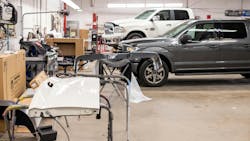Alexey Kryuchkov says it is just a pleasant coincidence that the Latin phrase est vis roughly translates to “the power.”
It is not what inspired the name of his similarly named management software, EstVis. EstVis is actually short for “estimate visualization.” But even if it’s accidental, two things can be true at once.
Spend a little time with the EstVis app and software and one can see that it is a powerful tool built around visualizing the repair process for all users. From the desktop dashboard with each vehicle in process to the mobile app in which users can track and update projects in real time, EstVis is all about simplicity. It’s what drove Kryuchkov to develop the software in the first place.
Though it was the oil business that initially brought Kryuchkov to the United States in 2010, he eventually found his way into collision repair. He founded Excel AutoBody, which has since grown to two locations in suburban Orlando, Florida. Kryuchkov wasn’t new to business, as he had previously owned a telecommunications company. As a “really young” person, he says, he rebuilt engines, so he wasn’t totally without a mechanical background either.
But managing a collision repair shop was still a new challenge, and he immediately identified what the main stumbling blocks were. And most often, it came back to documentation for the insurance company. The shop was taking thousands of photos, but off the camera there was no easy way to organize them. And, most importantly, there was no easy way to ensure that these photos stayed tied to the repair they belonged to.
“When you hook up the camera to the computer,” Kryuchkov says, “by the time you try to go through the supplements you don't understand like, ‘Yeah, I took this picture, but I don't even remember what it is for,’ because most of the time you work on like three or four cars at the same time. And you’re interrupted on the way by the technicians requesting a supplement on this car, and a painter requesting a supplement on that car when you walk through the shop.”
The solution, Kryuchkov thought, was to utilize the power of the smartphone. It already has a powerful camera, already has Wi-Fi, and is customizable. The result was a mobile application used by the customer, technicians, and managers alike, which feeds into a central desktop software that helps manage just about every operation in the shop.
That desktop view is called Workflow, and it’s the main production board for a shop. Projects are arranged in columns, each with a picture of the vehicle, and those projects can be arranged in “buckets” based on the stage of the repair process and those buckets can be renamed and customized. Users can easily drag and drop vehicles along the process.
“You can change the state like that, or, what’s a major difference between everybody else is, your employee can change the state from their mobile phone,” Kryuchkov says.
Technicians can add a myriad of new information through their phones. They can scan invoices and supplements and attach them to the vehicle. The idea is to eliminate paper wherever possible, paper that can get lost or disassociated with the project it belongs to.
“The major thing—this is how estimate visualization started—is to visualize your estimate to stop printing, unnecessarily wasting paper,” Kryuchkov says. “Like, you print the preliminary estimate, then you write it down, then you go back, you print the estimate with a preliminary supplement, then you find something else, and so on.”
The customer can perform their functions on the go as well. EstVis prompts customers to take damage photos, sign work authorizations, indicate when they plan to pick up their vehicle, and more. The software can send text messages and keep a record of the conversations. It can even make and receive phone calls.
“Customers are happy as well because they actually didn't spend that much time in the shop,” Kryuchkov says. “And also, most of the shops, they don't have a huge reception area. They want those customers to get in and get out. So that is the first thing we see, we hear customers are really happy with the updates, even though nobody actually is doing the updates. The system does it for them, as long as they start moving it through the stages.”
Systems Integration and Other Features
In addition to increasing shop efficiency, EstVis also is designed to save shops money. For instance, EstVis is integrated with major paint manufacturers such as PPG and Axalta. The system compares the estimate in relation to the paint being used and identifies discrepancies.
EstVis also integrates with estimating software so when any estimate is written, it is automatically’ exported to EstVis. The system then has the functionality to assign specific estimate lines to employees and edit lines as well.
One possible advantage to EstVis is that data storage is something of a hybrid between a cloud and permanent storage. A shop is able to access its data forever, rather than potentially losing access to it in the event it no longer uses a certain software. Data can be accessed from anywhere, and access can be granted or revoked by administrators.
EstVis has been in use for roughly eight years. “A lot” was the only indication of the number of users Kryuchkov was willing to give, but he notes that he has seen evidence of the software’s influence as its features show up in the updates of competitors.
As far as the future of management software, Kryuchkov pointed to increased development of real-time location (RTL) systems, particularly for larger clients such as dealerships with hundreds of cars on a lot. RTL systems can not only pinpoint where a car is, it can also be used to update where a car is in process when that car is taken to a certain location.
For now, Kryuchkov is pleased—and he says customers are pleased—with where EstVis is and enjoy its intuitive, easy-to-operate nature.
“It is built for the body shops because we have our own two shops,” says Kryuchkov. “... We want you, body shops, to not feel pressure from us that you have to learn something new. We want to have it (feel) natural.”
Users may learn more and download a demo version of the software at estvis.com.






